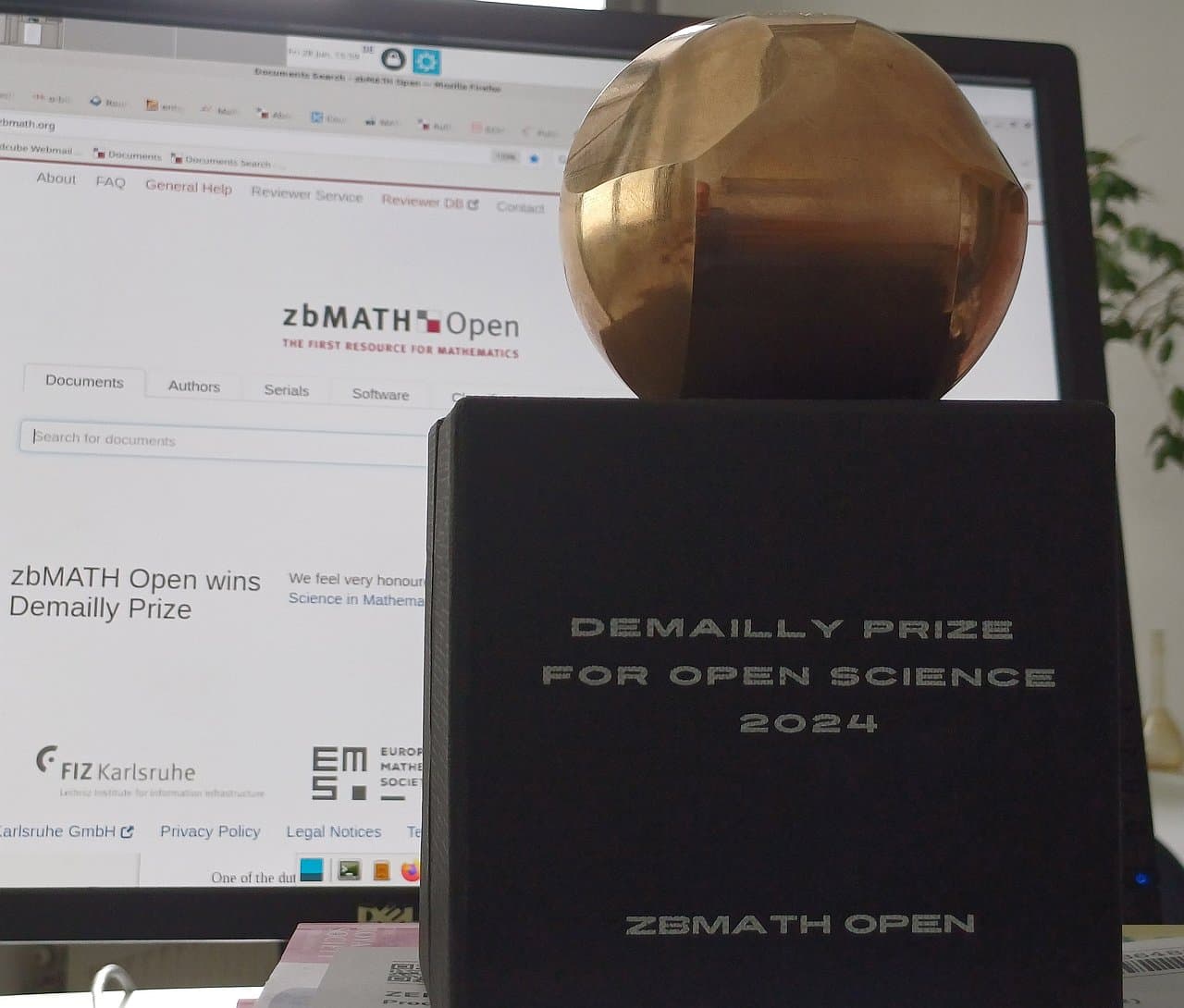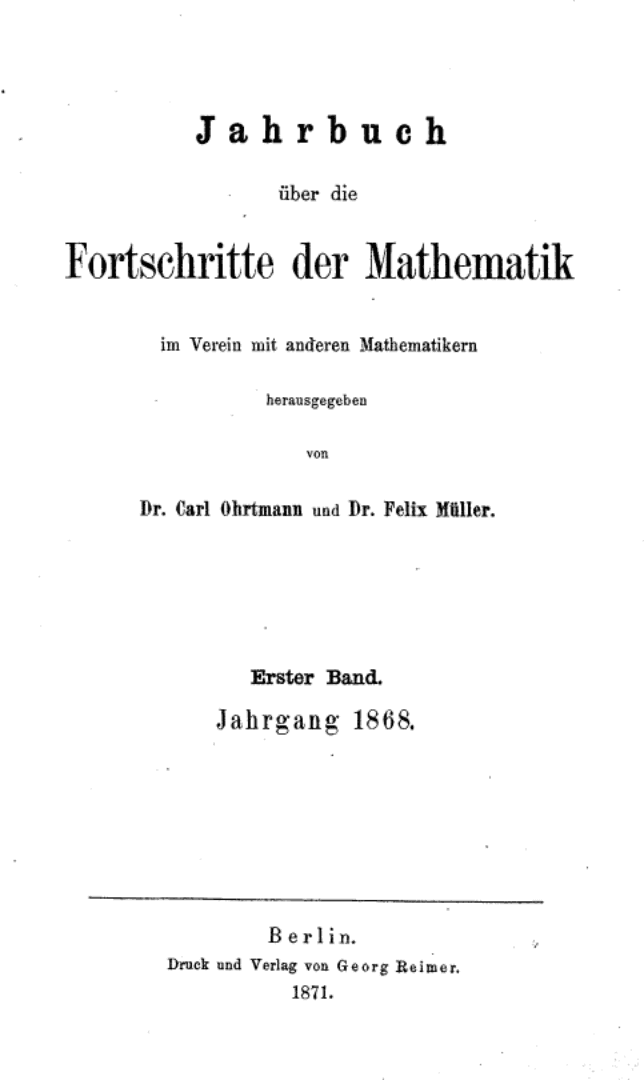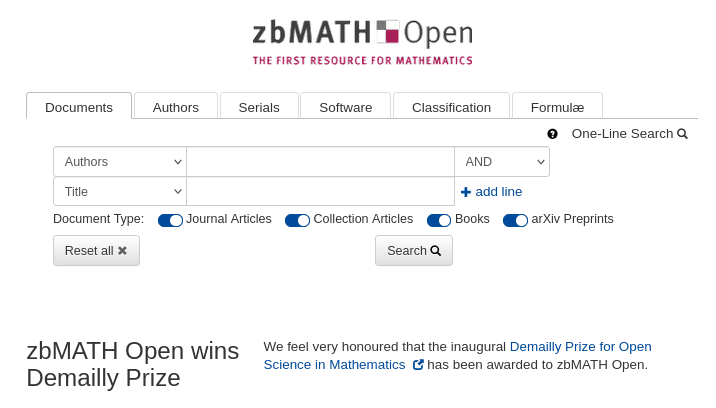After 7 very successful years as editor-in-chief of zbMATH Open,1https://zbmath.org my predecessor Klaus Hulek decided to hand over the baton to a successor. I was asked if I would be interested in this job and after a brief hesitation due to the time commitment involved, I decided to accept the challenge. One of the outstanding successes of my predecessor was certainly the transformation of zbMATH into an open access project, which was completed in 2021. This reorientation towards open science was recognized in June 2024 with the award of the first Demailly Prize for zbMATH Open.2https://epiga.episciences.org/page/session-2024
When the “Jahrbuch über die Fortschritte der Mathematik,” which later was fused with the “Zentralblatt für Mathematik und ihre Grenzgebiete,” first appeared in 1868, mathematical research data were essentially printed research articles and books. This was to remain the case for a long time. And the Zentralblatt was also published in printed form. I still remember how each volume of the Zentralblatt felt like it filled several meters of bookshelf and its use was associated with an endless amount of browsing. The younger ones among us probably can’t even imagine that. In the early 1990s, after the Zentralblatt had become available electronically on CD, there were discussions in my institute whether we should continue to obtain the printed version. Some colleagues first had to get used to the idea of having a work only available electronically rather than in printed form. After a few years, however, this discussion came to an end.
However, technological progress has not only changed the Zentralblatt, but above all the mathematical research data itself. Today, articles and books are also available electronically. There is also mathematical software, databases, videos, discussions on internet platforms, numerical simulations, formalized libraries for machine-verifiable proofs and much more that is now also of great importance for mathematical research. Indexing and integrating this sometimes very heterogeneous research data is a major challenge for zbMATH Open. The “Deutsche Forschungsgemeinschaft” (German Research Foundation) has recognized the importance of this problem and is funding the “Mathematical Research Data Initiative” MaRDI.3https://www.mardi4nfdi.de
Today, zbMATH Open contains almost 5 million documents from around 1.3 million authors. There are summaries of around 1.2 million documents written by reviewers specifically for zbMATH Open. About 46,000 software packages are referenced with cross-references to and from articles in which they play a significant role. There are references to various databases such as the “On-Line Encyclopedia of Integer Sequences”4https://oeis.org or the “Digital Library of Mathematical Functions”5https://dlmf.nist.gov and to mathematical discussion platforms such as “MathOverflow”.6https://mathoverflow.net
A significant new enhancement is the integration of arXiv preprints. These are recorded as a separate document type and merged with the published version after publication. This has various advantages for users. When searching for relevant literature, it is no longer necessary to carry out two searches, one in zbMATH and one in arXiv. The zbMATH database is much more up-to-date and there is now no longer just a link to the published version for the indexed documents, which may be behind a paywall, but also to the freely available arXiv version.
To make zbMATH as user-friendly as possible, the web interface is currently being revised. In addition to the familiar one-line search for more experienced users, a new, completely self-explanatory and intuitive search mask will be offered, which should be available by the time this article is published.
Anyone wishing to offer a service that uses zbMATH Open data is invited to do so, in keeping with the open nature of zbMATH Open. The new powerful application programming interface, the so-called REST API,7https://api.zbmath.org allows automated access with comprehensive filter functions.
The integration of further mathematical databases and other research data such as videos or formalized mathematics is the subject of lively internal debate. The benefits must always be weighed up against the costs. Sooner or later, there will probably be no way around it.
The spectacular advances in artificial intelligence, especially large language models, pose a particular challenge. Specially trained GPTs such as “Math Solver”8https://studyx.ai/math-solver are already able to provide reasonably meaningful explanations of simple mathematical questions, including references to the literature. It is to be expected that this technology will be further perfected in the near future. Imagine a language model that can provide reliable and comprehensive answers to mathematical questions in the field of current research based on zbMATH’s treasure trove of carefully curated data. What sounded like science fiction a few years ago may now be within the realm of possibility.
Cite this article
Christian Bär, zbMATH Open – Where do we stand and what’s next?. Eur. Math. Soc. Mag. 133 (2024), pp. 66–68
DOI 10.4171/MAG/214



